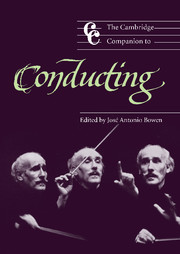3 - Studio conducting
from Part I - Practice
Published online by Cambridge University Press: 28 September 2011
Summary
A studio is not a concert hall and a recording is not a concert. A recording is music made objective. The experience of setting an interpretation into stone in a recording is a humbling one for even the most ego-crazed, over-coiffed, mega-multi-media-jet-setting superstar. It creates a multitude of unique problems which often require immediate decisions that have lasting and sometimes costly consequences. Much debate is focused on the battle between “live” and studio (by implication, “dead”!) performances, where intellectual laziness has exaggerated the claims for “live” recording. As with “live” theatre and film, the differences (in both means and ends) between recordings and concerts are so vast, that they are hardly the same art form, but we can enjoy both without needing to set one above the other. How do conductors adjust to these challenges and what does the producer do? The conductor in the studio, particularly for an opera recording, can be compared with a train driver on a journey from A to Z, but travelling from R to Z first, and A to B last, with all of the bits in between jumbled together, sometimes twice or three times over, to allow for passengers who missed the train the first time. At the end, one literally does not know if one is coming or going, or if all the passengers have been safely delivered. Not so far removed from the opera conductor is the conductor with a soloist. The studio magnifies the pressure on the conductor and presents an interesting opportunity to examine this exotic creative ego.
- Type
- Chapter
- Information
- The Cambridge Companion to Conducting , pp. 28 - 39Publisher: Cambridge University PressPrint publication year: 2003



